Project Selection Methods and Analysis: PROJ6000, Module 3 Report
VerifiedAdded on 2022/09/08
|10
|2359
|17
Report
AI Summary
This report provides a comprehensive overview of project selection methods, crucial for effective project management. It delves into two primary approaches: benefit measurement methods, which include comparative approaches, economic models (like cost-benefit ratio, DCF, NPV, and IRR), and scoring models; and constrained optimization methods, which involve mathematical models like linear, non-linear, integer, dynamic, and multiple objective programming. The report highlights the importance of selecting projects that align with organizational goals and ensure a return on investment. Furthermore, it outlines the initial project processes, encompassing inputs, tools, techniques, and outputs, along with project documents such as product descriptions, planning strategies, and selection criteria. The report uses the Maxima case study to illustrate the application of these methods and the significance of project selection in achieving organizational objectives such as increased turnover and market growth. It emphasizes the need for organizations to carefully analyze project opportunities and make informed investment decisions to maximize benefits.
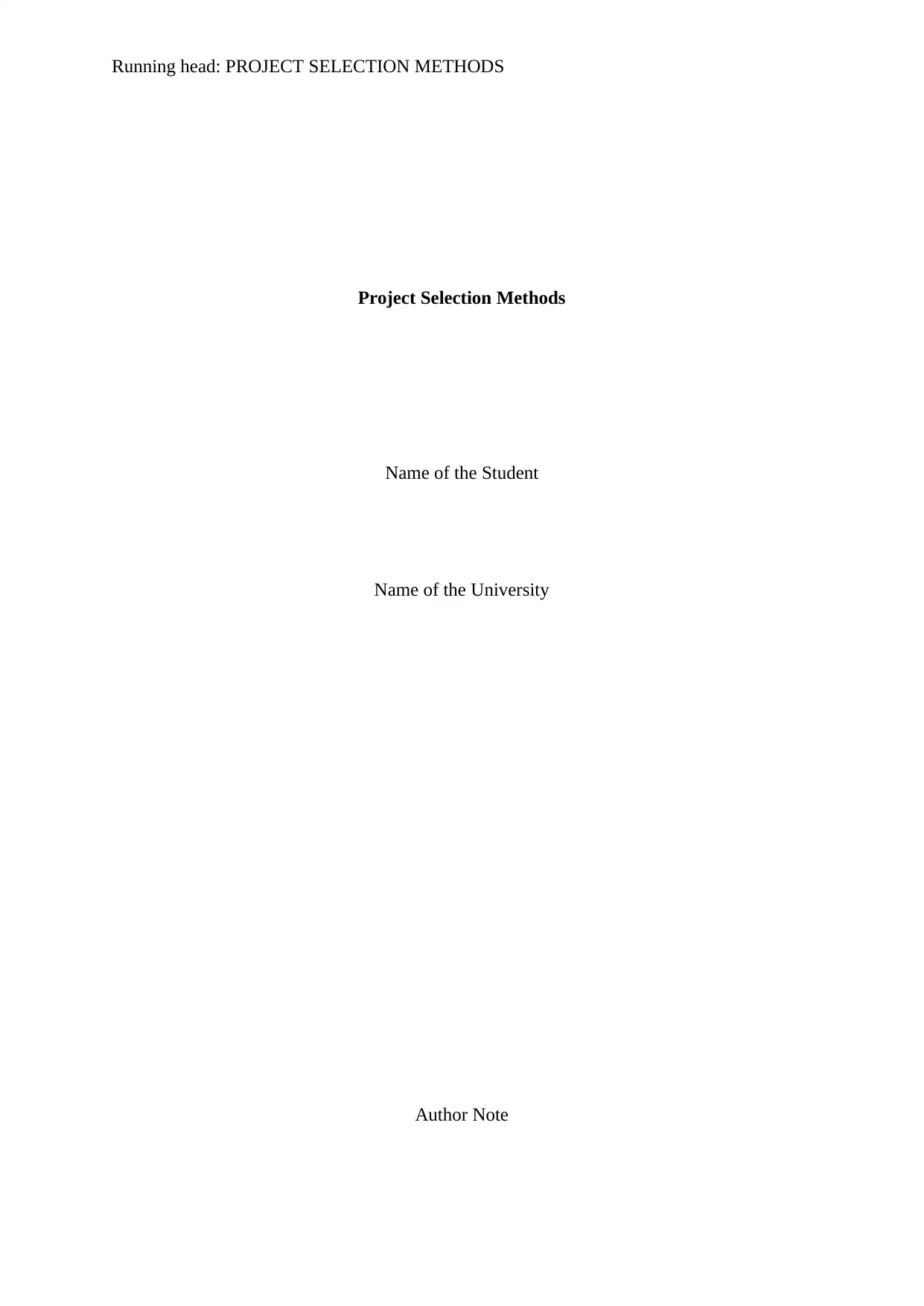
Running head: PROJECT SELECTION METHODS
Project Selection Methods
Name of the Student
Name of the University
Author Note
Project Selection Methods
Name of the Student
Name of the University
Author Note
Paraphrase This Document
Need a fresh take? Get an instant paraphrase of this document with our AI Paraphraser

1
PROJECT SELECTION METHODS
Table of Contents
Introduction................................................................................................................................2
Discussion..................................................................................................................................2
Benefit measurement methods:..............................................................................................2
Constrained optimization methods.........................................................................................3
Conclusion .................................................................................................................................3
PROJECT SELECTION METHODS
Table of Contents
Introduction................................................................................................................................2
Discussion..................................................................................................................................2
Benefit measurement methods:..............................................................................................2
Constrained optimization methods.........................................................................................3
Conclusion .................................................................................................................................3
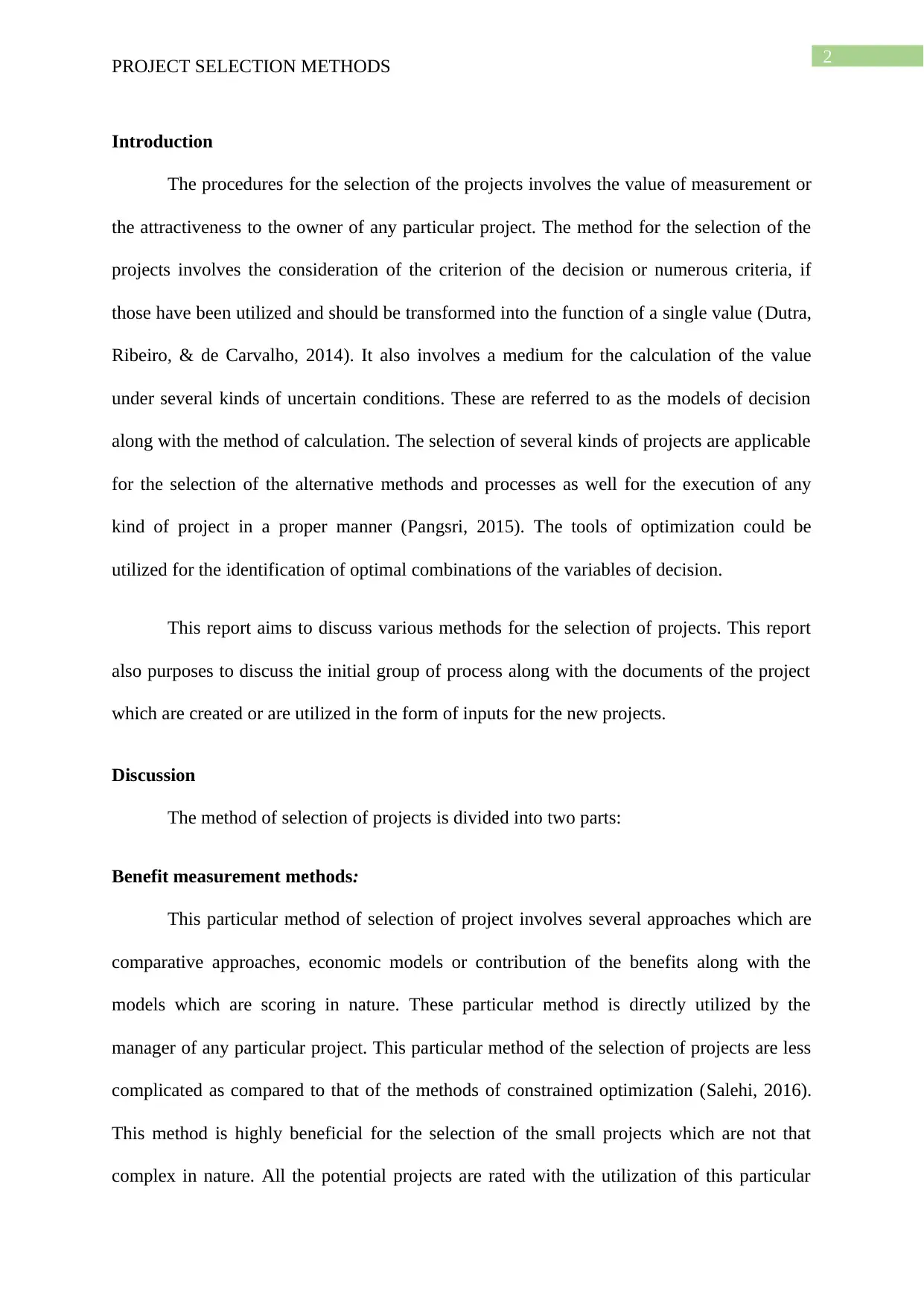
2
PROJECT SELECTION METHODS
Introduction
The procedures for the selection of the projects involves the value of measurement or
the attractiveness to the owner of any particular project. The method for the selection of the
projects involves the consideration of the criterion of the decision or numerous criteria, if
those have been utilized and should be transformed into the function of a single value (Dutra,
Ribeiro, & de Carvalho, 2014). It also involves a medium for the calculation of the value
under several kinds of uncertain conditions. These are referred to as the models of decision
along with the method of calculation. The selection of several kinds of projects are applicable
for the selection of the alternative methods and processes as well for the execution of any
kind of project in a proper manner (Pangsri, 2015). The tools of optimization could be
utilized for the identification of optimal combinations of the variables of decision.
This report aims to discuss various methods for the selection of projects. This report
also purposes to discuss the initial group of process along with the documents of the project
which are created or are utilized in the form of inputs for the new projects.
Discussion
The method of selection of projects is divided into two parts:
Benefit measurement methods:
This particular method of selection of project involves several approaches which are
comparative approaches, economic models or contribution of the benefits along with the
models which are scoring in nature. These particular method is directly utilized by the
manager of any particular project. This particular method of the selection of projects are less
complicated as compared to that of the methods of constrained optimization (Salehi, 2016).
This method is highly beneficial for the selection of the small projects which are not that
complex in nature. All the potential projects are rated with the utilization of this particular
PROJECT SELECTION METHODS
Introduction
The procedures for the selection of the projects involves the value of measurement or
the attractiveness to the owner of any particular project. The method for the selection of the
projects involves the consideration of the criterion of the decision or numerous criteria, if
those have been utilized and should be transformed into the function of a single value (Dutra,
Ribeiro, & de Carvalho, 2014). It also involves a medium for the calculation of the value
under several kinds of uncertain conditions. These are referred to as the models of decision
along with the method of calculation. The selection of several kinds of projects are applicable
for the selection of the alternative methods and processes as well for the execution of any
kind of project in a proper manner (Pangsri, 2015). The tools of optimization could be
utilized for the identification of optimal combinations of the variables of decision.
This report aims to discuss various methods for the selection of projects. This report
also purposes to discuss the initial group of process along with the documents of the project
which are created or are utilized in the form of inputs for the new projects.
Discussion
The method of selection of projects is divided into two parts:
Benefit measurement methods:
This particular method of selection of project involves several approaches which are
comparative approaches, economic models or contribution of the benefits along with the
models which are scoring in nature. These particular method is directly utilized by the
manager of any particular project. This particular method of the selection of projects are less
complicated as compared to that of the methods of constrained optimization (Salehi, 2016).
This method is highly beneficial for the selection of the small projects which are not that
complex in nature. All the potential projects are rated with the utilization of this particular
⊘ This is a preview!⊘
Do you want full access?
Subscribe today to unlock all pages.

Trusted by 1+ million students worldwide
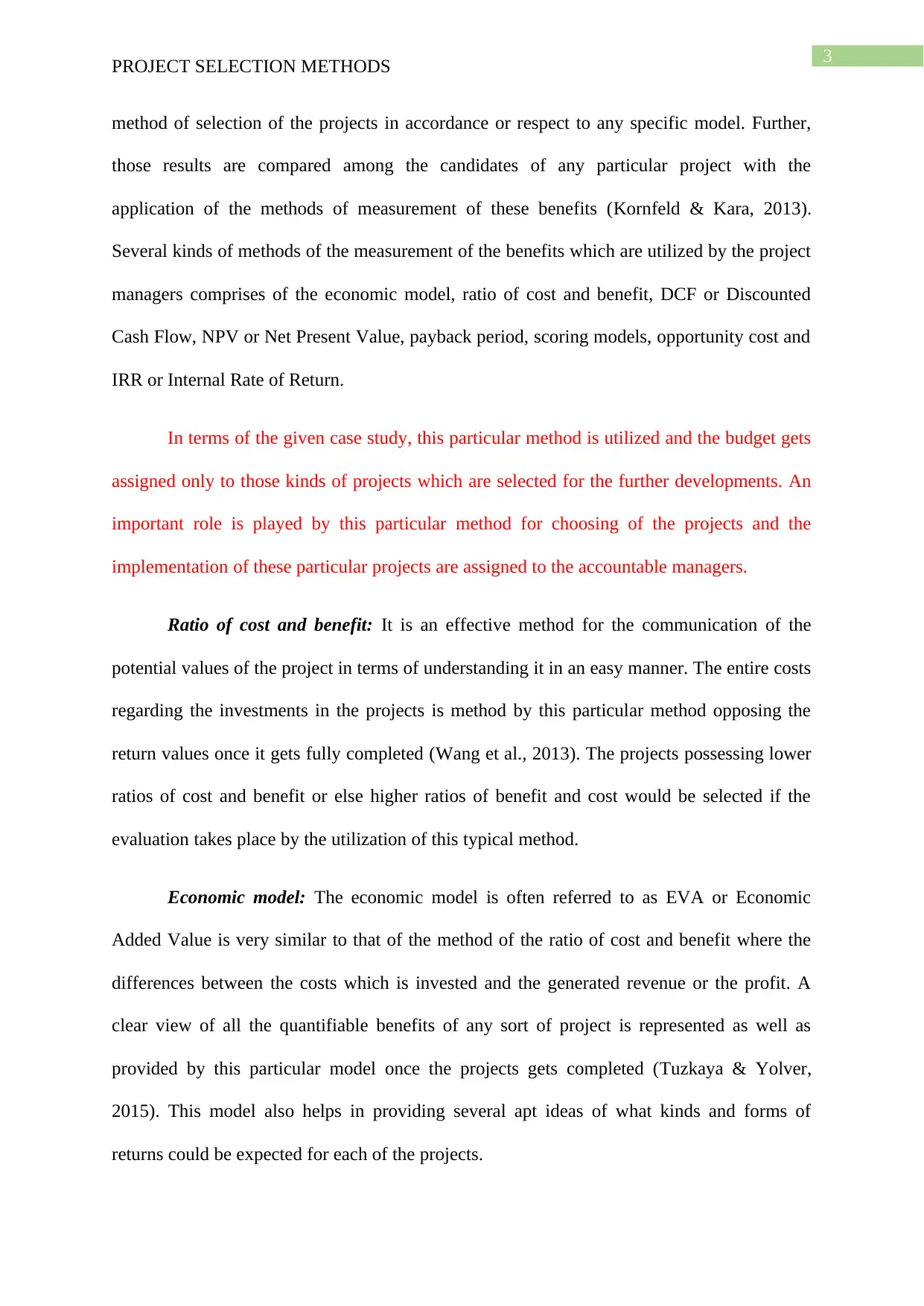
3
PROJECT SELECTION METHODS
method of selection of the projects in accordance or respect to any specific model. Further,
those results are compared among the candidates of any particular project with the
application of the methods of measurement of these benefits (Kornfeld & Kara, 2013).
Several kinds of methods of the measurement of the benefits which are utilized by the project
managers comprises of the economic model, ratio of cost and benefit, DCF or Discounted
Cash Flow, NPV or Net Present Value, payback period, scoring models, opportunity cost and
IRR or Internal Rate of Return.
In terms of the given case study, this particular method is utilized and the budget gets
assigned only to those kinds of projects which are selected for the further developments. An
important role is played by this particular method for choosing of the projects and the
implementation of these particular projects are assigned to the accountable managers.
Ratio of cost and benefit: It is an effective method for the communication of the
potential values of the project in terms of understanding it in an easy manner. The entire costs
regarding the investments in the projects is method by this particular method opposing the
return values once it gets fully completed (Wang et al., 2013). The projects possessing lower
ratios of cost and benefit or else higher ratios of benefit and cost would be selected if the
evaluation takes place by the utilization of this typical method.
Economic model: The economic model is often referred to as EVA or Economic
Added Value is very similar to that of the method of the ratio of cost and benefit where the
differences between the costs which is invested and the generated revenue or the profit. A
clear view of all the quantifiable benefits of any sort of project is represented as well as
provided by this particular model once the projects gets completed (Tuzkaya & Yolver,
2015). This model also helps in providing several apt ideas of what kinds and forms of
returns could be expected for each of the projects.
PROJECT SELECTION METHODS
method of selection of the projects in accordance or respect to any specific model. Further,
those results are compared among the candidates of any particular project with the
application of the methods of measurement of these benefits (Kornfeld & Kara, 2013).
Several kinds of methods of the measurement of the benefits which are utilized by the project
managers comprises of the economic model, ratio of cost and benefit, DCF or Discounted
Cash Flow, NPV or Net Present Value, payback period, scoring models, opportunity cost and
IRR or Internal Rate of Return.
In terms of the given case study, this particular method is utilized and the budget gets
assigned only to those kinds of projects which are selected for the further developments. An
important role is played by this particular method for choosing of the projects and the
implementation of these particular projects are assigned to the accountable managers.
Ratio of cost and benefit: It is an effective method for the communication of the
potential values of the project in terms of understanding it in an easy manner. The entire costs
regarding the investments in the projects is method by this particular method opposing the
return values once it gets fully completed (Wang et al., 2013). The projects possessing lower
ratios of cost and benefit or else higher ratios of benefit and cost would be selected if the
evaluation takes place by the utilization of this typical method.
Economic model: The economic model is often referred to as EVA or Economic
Added Value is very similar to that of the method of the ratio of cost and benefit where the
differences between the costs which is invested and the generated revenue or the profit. A
clear view of all the quantifiable benefits of any sort of project is represented as well as
provided by this particular model once the projects gets completed (Tuzkaya & Yolver,
2015). This model also helps in providing several apt ideas of what kinds and forms of
returns could be expected for each of the projects.
Paraphrase This Document
Need a fresh take? Get an instant paraphrase of this document with our AI Paraphraser
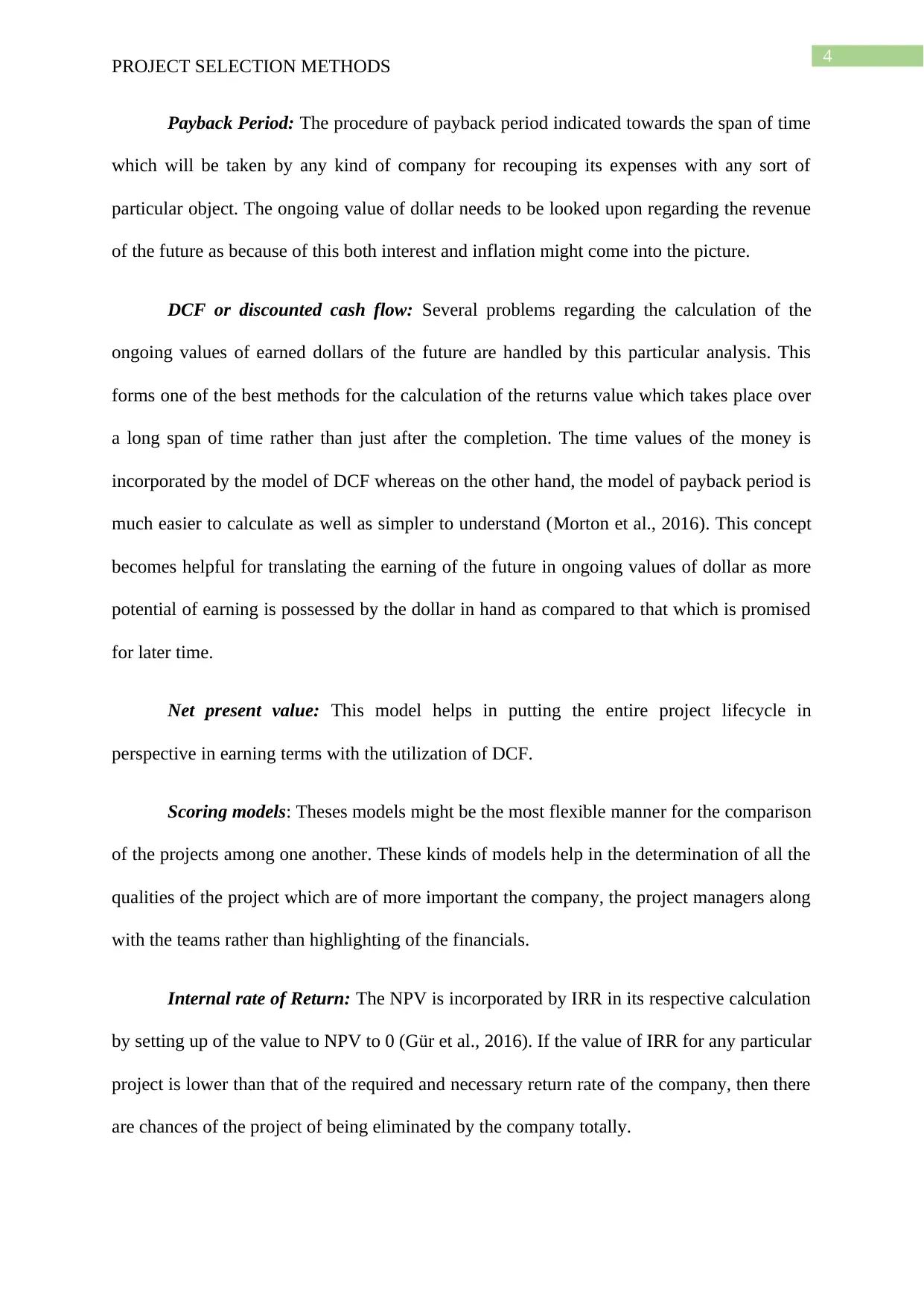
4
PROJECT SELECTION METHODS
Payback Period: The procedure of payback period indicated towards the span of time
which will be taken by any kind of company for recouping its expenses with any sort of
particular object. The ongoing value of dollar needs to be looked upon regarding the revenue
of the future as because of this both interest and inflation might come into the picture.
DCF or discounted cash flow: Several problems regarding the calculation of the
ongoing values of earned dollars of the future are handled by this particular analysis. This
forms one of the best methods for the calculation of the returns value which takes place over
a long span of time rather than just after the completion. The time values of the money is
incorporated by the model of DCF whereas on the other hand, the model of payback period is
much easier to calculate as well as simpler to understand (Morton et al., 2016). This concept
becomes helpful for translating the earning of the future in ongoing values of dollar as more
potential of earning is possessed by the dollar in hand as compared to that which is promised
for later time.
Net present value: This model helps in putting the entire project lifecycle in
perspective in earning terms with the utilization of DCF.
Scoring models: Theses models might be the most flexible manner for the comparison
of the projects among one another. These kinds of models help in the determination of all the
qualities of the project which are of more important the company, the project managers along
with the teams rather than highlighting of the financials.
Internal rate of Return: The NPV is incorporated by IRR in its respective calculation
by setting up of the value to NPV to 0 (Gür et al., 2016). If the value of IRR for any particular
project is lower than that of the required and necessary return rate of the company, then there
are chances of the project of being eliminated by the company totally.
PROJECT SELECTION METHODS
Payback Period: The procedure of payback period indicated towards the span of time
which will be taken by any kind of company for recouping its expenses with any sort of
particular object. The ongoing value of dollar needs to be looked upon regarding the revenue
of the future as because of this both interest and inflation might come into the picture.
DCF or discounted cash flow: Several problems regarding the calculation of the
ongoing values of earned dollars of the future are handled by this particular analysis. This
forms one of the best methods for the calculation of the returns value which takes place over
a long span of time rather than just after the completion. The time values of the money is
incorporated by the model of DCF whereas on the other hand, the model of payback period is
much easier to calculate as well as simpler to understand (Morton et al., 2016). This concept
becomes helpful for translating the earning of the future in ongoing values of dollar as more
potential of earning is possessed by the dollar in hand as compared to that which is promised
for later time.
Net present value: This model helps in putting the entire project lifecycle in
perspective in earning terms with the utilization of DCF.
Scoring models: Theses models might be the most flexible manner for the comparison
of the projects among one another. These kinds of models help in the determination of all the
qualities of the project which are of more important the company, the project managers along
with the teams rather than highlighting of the financials.
Internal rate of Return: The NPV is incorporated by IRR in its respective calculation
by setting up of the value to NPV to 0 (Gür et al., 2016). If the value of IRR for any particular
project is lower than that of the required and necessary return rate of the company, then there
are chances of the project of being eliminated by the company totally.

5
PROJECT SELECTION METHODS
Opportunity cost: Opportunity cost indicates towards a technique which is
supplemental in nature as compared to that of a standalone procedure and it forms a great
method of putting certain choices of projects into perspectives.
Constrained optimization methods
This method of selection of the projects is good for greater and more intricate projects
which involves several kinds of mathematical calculation which are intricate in nature should
be performed (Oztaysi, 2015). On the other hand, the methods of measurements of benefits
are mostly utilized by the managers of several kinds of projects (Wu et al., 2017). These
method of selection of projects are often referred to as the mathematical model for the
selection of the projects. But on the other hand, the method of the measurement of benefits
are mostly selected by huge numbers of managers of projects for meeting the needs of the
selection of the projects.
In the context of the provided case study, higher levels of competency have been
developed by MAXIMA along with providing convenient shopping levels to its customers
via the method of availability of several suitable formats of shopping among them. Several
services comprises of insurance services, services of mobile communications etc. (Dutra,
Ribeiro & de Carvalho, 2014). The improvement of the projects involves the responsibilities
of surveying trends along with novelties in certain areas along with the making of proposals.
New services are aimed to be added to the ongoing portfolio along with the continuous
analysis of the options of self-service of the customers.
Several methods of constrained optimization are mentioned below:
Linear Programming: This particular method of programming includes bringing
downwards of the total project cost via the process of reduction of time which is necessary
for the completion of the project (Huang et al., 2016).
PROJECT SELECTION METHODS
Opportunity cost: Opportunity cost indicates towards a technique which is
supplemental in nature as compared to that of a standalone procedure and it forms a great
method of putting certain choices of projects into perspectives.
Constrained optimization methods
This method of selection of the projects is good for greater and more intricate projects
which involves several kinds of mathematical calculation which are intricate in nature should
be performed (Oztaysi, 2015). On the other hand, the methods of measurements of benefits
are mostly utilized by the managers of several kinds of projects (Wu et al., 2017). These
method of selection of projects are often referred to as the mathematical model for the
selection of the projects. But on the other hand, the method of the measurement of benefits
are mostly selected by huge numbers of managers of projects for meeting the needs of the
selection of the projects.
In the context of the provided case study, higher levels of competency have been
developed by MAXIMA along with providing convenient shopping levels to its customers
via the method of availability of several suitable formats of shopping among them. Several
services comprises of insurance services, services of mobile communications etc. (Dutra,
Ribeiro & de Carvalho, 2014). The improvement of the projects involves the responsibilities
of surveying trends along with novelties in certain areas along with the making of proposals.
New services are aimed to be added to the ongoing portfolio along with the continuous
analysis of the options of self-service of the customers.
Several methods of constrained optimization are mentioned below:
Linear Programming: This particular method of programming includes bringing
downwards of the total project cost via the process of reduction of time which is necessary
for the completion of the project (Huang et al., 2016).
⊘ This is a preview!⊘
Do you want full access?
Subscribe today to unlock all pages.

Trusted by 1+ million students worldwide
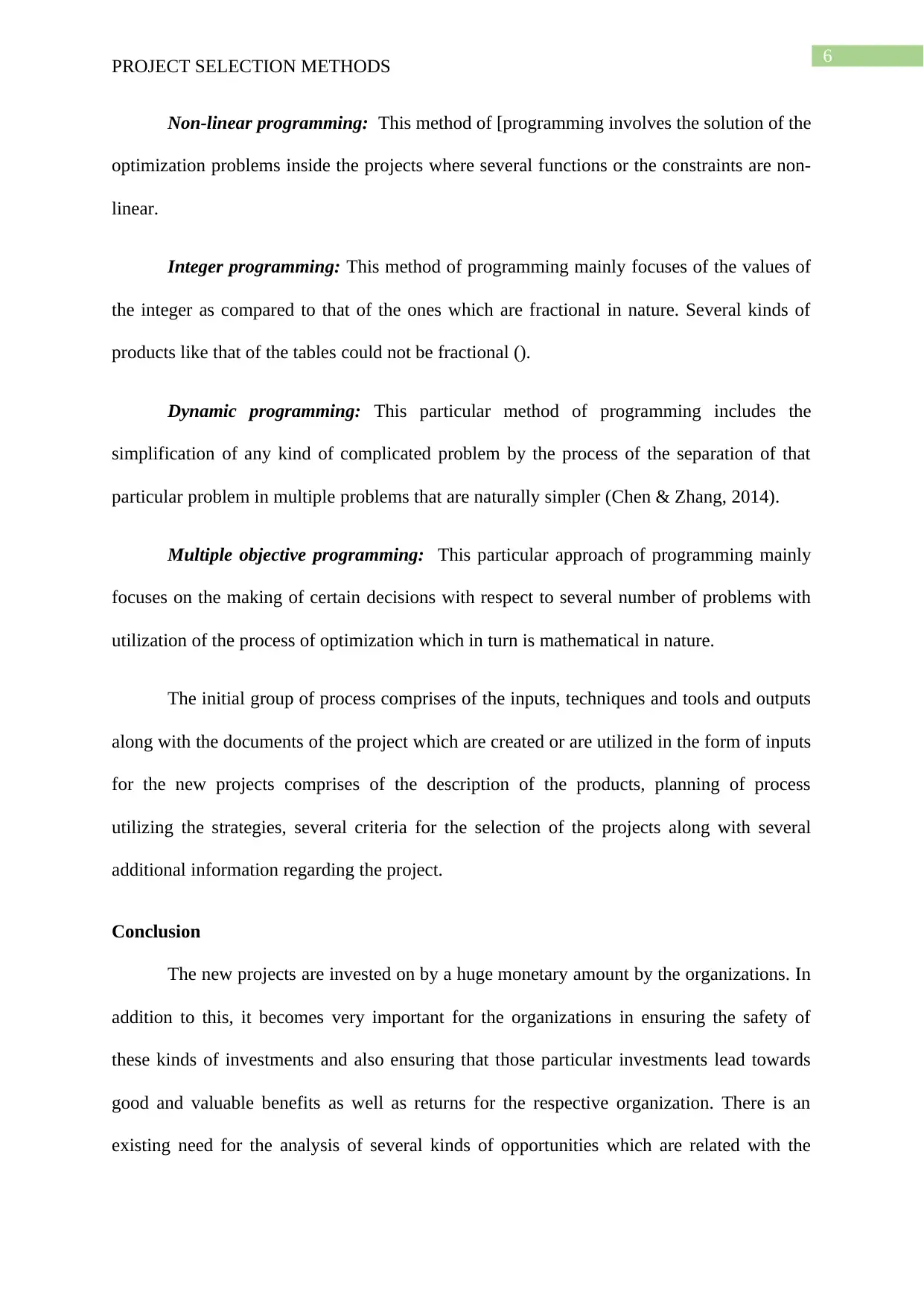
6
PROJECT SELECTION METHODS
Non-linear programming: This method of [programming involves the solution of the
optimization problems inside the projects where several functions or the constraints are non-
linear.
Integer programming: This method of programming mainly focuses of the values of
the integer as compared to that of the ones which are fractional in nature. Several kinds of
products like that of the tables could not be fractional ().
Dynamic programming: This particular method of programming includes the
simplification of any kind of complicated problem by the process of the separation of that
particular problem in multiple problems that are naturally simpler (Chen & Zhang, 2014).
Multiple objective programming: This particular approach of programming mainly
focuses on the making of certain decisions with respect to several number of problems with
utilization of the process of optimization which in turn is mathematical in nature.
The initial group of process comprises of the inputs, techniques and tools and outputs
along with the documents of the project which are created or are utilized in the form of inputs
for the new projects comprises of the description of the products, planning of process
utilizing the strategies, several criteria for the selection of the projects along with several
additional information regarding the project.
Conclusion
The new projects are invested on by a huge monetary amount by the organizations. In
addition to this, it becomes very important for the organizations in ensuring the safety of
these kinds of investments and also ensuring that those particular investments lead towards
good and valuable benefits as well as returns for the respective organization. There is an
existing need for the analysis of several kinds of opportunities which are related with the
PROJECT SELECTION METHODS
Non-linear programming: This method of [programming involves the solution of the
optimization problems inside the projects where several functions or the constraints are non-
linear.
Integer programming: This method of programming mainly focuses of the values of
the integer as compared to that of the ones which are fractional in nature. Several kinds of
products like that of the tables could not be fractional ().
Dynamic programming: This particular method of programming includes the
simplification of any kind of complicated problem by the process of the separation of that
particular problem in multiple problems that are naturally simpler (Chen & Zhang, 2014).
Multiple objective programming: This particular approach of programming mainly
focuses on the making of certain decisions with respect to several number of problems with
utilization of the process of optimization which in turn is mathematical in nature.
The initial group of process comprises of the inputs, techniques and tools and outputs
along with the documents of the project which are created or are utilized in the form of inputs
for the new projects comprises of the description of the products, planning of process
utilizing the strategies, several criteria for the selection of the projects along with several
additional information regarding the project.
Conclusion
The new projects are invested on by a huge monetary amount by the organizations. In
addition to this, it becomes very important for the organizations in ensuring the safety of
these kinds of investments and also ensuring that those particular investments lead towards
good and valuable benefits as well as returns for the respective organization. There is an
existing need for the analysis of several kinds of opportunities which are related with the
Paraphrase This Document
Need a fresh take? Get an instant paraphrase of this document with our AI Paraphraser
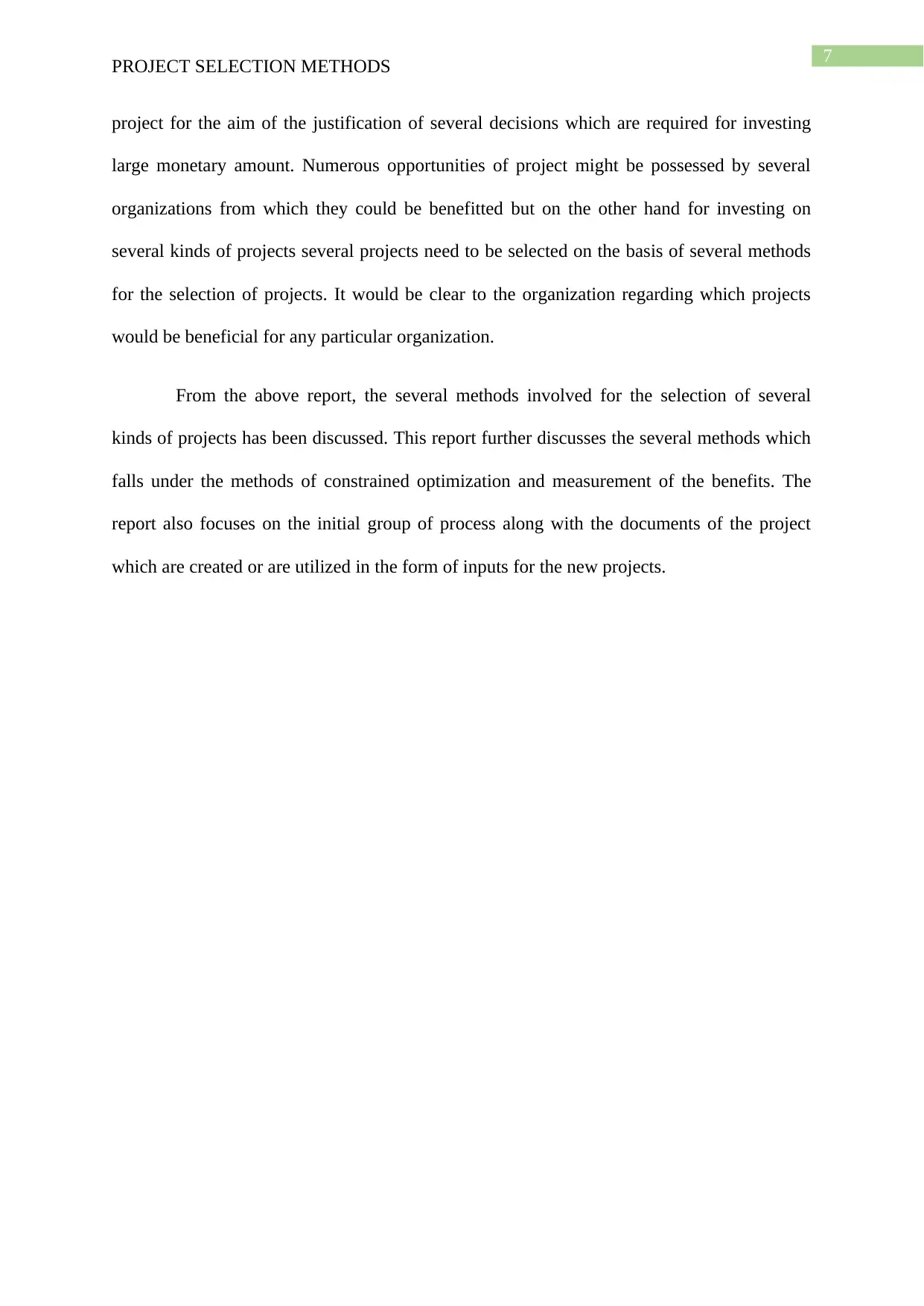
7
PROJECT SELECTION METHODS
project for the aim of the justification of several decisions which are required for investing
large monetary amount. Numerous opportunities of project might be possessed by several
organizations from which they could be benefitted but on the other hand for investing on
several kinds of projects several projects need to be selected on the basis of several methods
for the selection of projects. It would be clear to the organization regarding which projects
would be beneficial for any particular organization.
From the above report, the several methods involved for the selection of several
kinds of projects has been discussed. This report further discusses the several methods which
falls under the methods of constrained optimization and measurement of the benefits. The
report also focuses on the initial group of process along with the documents of the project
which are created or are utilized in the form of inputs for the new projects.
PROJECT SELECTION METHODS
project for the aim of the justification of several decisions which are required for investing
large monetary amount. Numerous opportunities of project might be possessed by several
organizations from which they could be benefitted but on the other hand for investing on
several kinds of projects several projects need to be selected on the basis of several methods
for the selection of projects. It would be clear to the organization regarding which projects
would be beneficial for any particular organization.
From the above report, the several methods involved for the selection of several
kinds of projects has been discussed. This report further discusses the several methods which
falls under the methods of constrained optimization and measurement of the benefits. The
report also focuses on the initial group of process along with the documents of the project
which are created or are utilized in the form of inputs for the new projects.
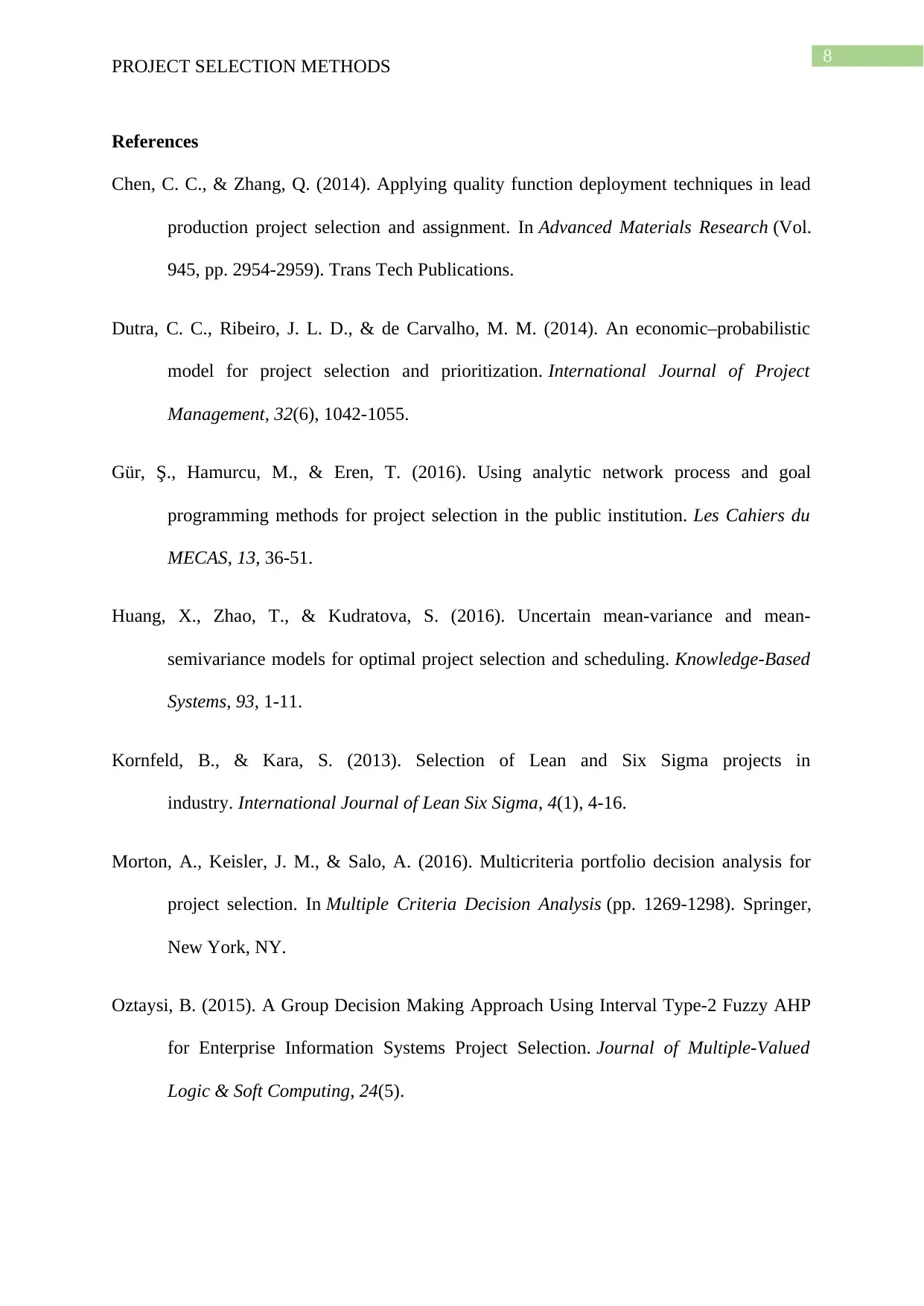
8
PROJECT SELECTION METHODS
References
Chen, C. C., & Zhang, Q. (2014). Applying quality function deployment techniques in lead
production project selection and assignment. In Advanced Materials Research (Vol.
945, pp. 2954-2959). Trans Tech Publications.
Dutra, C. C., Ribeiro, J. L. D., & de Carvalho, M. M. (2014). An economic–probabilistic
model for project selection and prioritization. International Journal of Project
Management, 32(6), 1042-1055.
Gür, Ş., Hamurcu, M., & Eren, T. (2016). Using analytic network process and goal
programming methods for project selection in the public institution. Les Cahiers du
MECAS, 13, 36-51.
Huang, X., Zhao, T., & Kudratova, S. (2016). Uncertain mean-variance and mean-
semivariance models for optimal project selection and scheduling. Knowledge-Based
Systems, 93, 1-11.
Kornfeld, B., & Kara, S. (2013). Selection of Lean and Six Sigma projects in
industry. International Journal of Lean Six Sigma, 4(1), 4-16.
Morton, A., Keisler, J. M., & Salo, A. (2016). Multicriteria portfolio decision analysis for
project selection. In Multiple Criteria Decision Analysis (pp. 1269-1298). Springer,
New York, NY.
Oztaysi, B. (2015). A Group Decision Making Approach Using Interval Type-2 Fuzzy AHP
for Enterprise Information Systems Project Selection. Journal of Multiple-Valued
Logic & Soft Computing, 24(5).
PROJECT SELECTION METHODS
References
Chen, C. C., & Zhang, Q. (2014). Applying quality function deployment techniques in lead
production project selection and assignment. In Advanced Materials Research (Vol.
945, pp. 2954-2959). Trans Tech Publications.
Dutra, C. C., Ribeiro, J. L. D., & de Carvalho, M. M. (2014). An economic–probabilistic
model for project selection and prioritization. International Journal of Project
Management, 32(6), 1042-1055.
Gür, Ş., Hamurcu, M., & Eren, T. (2016). Using analytic network process and goal
programming methods for project selection in the public institution. Les Cahiers du
MECAS, 13, 36-51.
Huang, X., Zhao, T., & Kudratova, S. (2016). Uncertain mean-variance and mean-
semivariance models for optimal project selection and scheduling. Knowledge-Based
Systems, 93, 1-11.
Kornfeld, B., & Kara, S. (2013). Selection of Lean and Six Sigma projects in
industry. International Journal of Lean Six Sigma, 4(1), 4-16.
Morton, A., Keisler, J. M., & Salo, A. (2016). Multicriteria portfolio decision analysis for
project selection. In Multiple Criteria Decision Analysis (pp. 1269-1298). Springer,
New York, NY.
Oztaysi, B. (2015). A Group Decision Making Approach Using Interval Type-2 Fuzzy AHP
for Enterprise Information Systems Project Selection. Journal of Multiple-Valued
Logic & Soft Computing, 24(5).
⊘ This is a preview!⊘
Do you want full access?
Subscribe today to unlock all pages.

Trusted by 1+ million students worldwide

9
PROJECT SELECTION METHODS
Pangsri, P. (2015). Application of the multi criteria decision making methods for project
selection. Universal Journal of Management, 3(1), 15-20.
Salehi, K. (2015). A hybrid fuzzy MCDM approach for project selection problem. Decision
Science Letters, 4(1), 109-116.
Tuzkaya, U. R., & Yolver, E. (2015). R&D project selection by integrated grey analytic
network process and grey relational analysis: an implementation for home appliances
company. Journal of Aeronautics and Space Technologies, 8(2), 35-41.
Wang, W. M., Lee, A. H., Peng, L. P., & Wu, Z. L. (2013). An integrated decision making
model for district revitalization and regeneration project selection. Decision Support
Systems, 54(2), 1092-1103.
Wu, S., Toussaint, J., & Messer, K. D. (2017). Maximizing benefits in project selection: a
hybrid approach. Applied Economics, 49(40), 4071-4082.
PROJECT SELECTION METHODS
Pangsri, P. (2015). Application of the multi criteria decision making methods for project
selection. Universal Journal of Management, 3(1), 15-20.
Salehi, K. (2015). A hybrid fuzzy MCDM approach for project selection problem. Decision
Science Letters, 4(1), 109-116.
Tuzkaya, U. R., & Yolver, E. (2015). R&D project selection by integrated grey analytic
network process and grey relational analysis: an implementation for home appliances
company. Journal of Aeronautics and Space Technologies, 8(2), 35-41.
Wang, W. M., Lee, A. H., Peng, L. P., & Wu, Z. L. (2013). An integrated decision making
model for district revitalization and regeneration project selection. Decision Support
Systems, 54(2), 1092-1103.
Wu, S., Toussaint, J., & Messer, K. D. (2017). Maximizing benefits in project selection: a
hybrid approach. Applied Economics, 49(40), 4071-4082.
1 out of 10
Related Documents
Your All-in-One AI-Powered Toolkit for Academic Success.
+13062052269
info@desklib.com
Available 24*7 on WhatsApp / Email
![[object Object]](/_next/static/media/star-bottom.7253800d.svg)
Unlock your academic potential
Copyright © 2020–2025 A2Z Services. All Rights Reserved. Developed and managed by ZUCOL.




